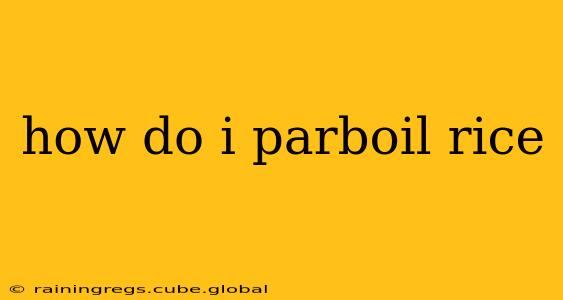Parboiling rice, also known as pre-boiling, is a process that involves partially cooking the grains before milling. This simple technique significantly enhances the rice's nutritional value, texture, and cooking time. While you might not parboil rice yourself from raw grains, understanding the process helps you appreciate the qualities of parboiled rice and how best to cook it. This guide will explore everything you need to know about parboiling rice and how to perfectly cook it at home.
What is Parboiled Rice?
Parboiled rice undergoes a three-step process:
- Soaking: The unmilled rice is soaked in water.
- Steaming: The soaked rice is then steamed under pressure. This steaming process pushes nutrients from the bran into the endosperm, the starchy core of the grain.
- Drying: Finally, the steamed rice is dried. This process helps to preserve the nutrients and firm up the grain.
This process results in rice that retains more nutrients (like vitamins and minerals) compared to regular white rice. It also has a firmer texture and cooks faster.
How to Cook Parboiled Rice: A Step-by-Step Guide
Cooking parboiled rice is straightforward and similar to cooking regular rice, but with a few key differences. Here's a simple method:
- Rinse: Rinse the rice under cold water until the water runs clear. This removes excess starch and helps prevent sticking.
- Ratio: Use a rice-to-water ratio of approximately 1:2 (one cup of rice to two cups of water). You may need to adjust this slightly depending on your stovetop and the specific brand of rice.
- Boil: Bring the water to a rolling boil in a saucepan with a tight-fitting lid.
- Add Rice: Add the rinsed rice to the boiling water.
- Simmer: Reduce heat to low, cover the pan tightly, and simmer for the time specified on the package (usually around 20-25 minutes). Do not lift the lid during this time.
- Rest: Once the cooking time is complete, remove the pan from the heat and let the rice sit, covered, for 5-10 minutes. This allows the steam to finish cooking the rice.
- Fluff: After resting, fluff the rice with a fork before serving.
What are the Benefits of Using Parboiled Rice?
Parboiling rice offers several advantages:
- Increased Nutritional Value: Parboiling locks in more nutrients, making it a healthier option.
- Firmer Texture: The cooking process results in rice that holds its shape better, ideal for dishes like rice salads or pilafs.
- Faster Cooking Time: Parboiled rice cooks quicker than regular white rice.
- Longer Shelf Life: It tends to have a longer shelf life due to the steaming and drying process.
What is the Difference Between Parboiled and Regular Rice?
The key differences lie in the processing and resulting qualities:
- Processing: Parboiled rice undergoes a pre-boiling treatment before milling, while regular white rice is milled directly after harvesting.
- Nutrient Content: Parboiled rice retains more nutrients, especially B vitamins and minerals.
- Texture: Parboiled rice has a firmer, slightly chewier texture, while regular white rice is softer.
- Cooking Time: Parboiled rice cooks faster.
- Appearance: Parboiled rice often has a slightly yellow tint compared to the bright white of regular white rice.
Is Parboiled Rice Healthier Than White Rice?
Yes, generally speaking, parboiled rice is considered healthier than regular white rice due to its higher nutrient content. The parboiling process helps retain more vitamins and minerals that are lost during the milling of regular white rice.
Can I Use Parboiled Rice in Any Recipe?
Yes, you can use parboiled rice in almost any recipe that calls for white rice. However, its firmer texture might be more suitable for dishes where the rice needs to hold its shape, such as rice salads or fried rice. It might not be the best choice for dishes requiring very soft, fluffy rice.
How Long Does Parboiled Rice Last?
Properly stored, parboiled rice can last for a considerable time, often several months or even longer, without losing its quality. Always store it in an airtight container in a cool, dry place.
This comprehensive guide should help you understand and master the art of cooking parboiled rice, unlocking its numerous benefits and culinary versatility. Remember to always check the packaging instructions for specific cooking times and ratios for your brand of rice.
